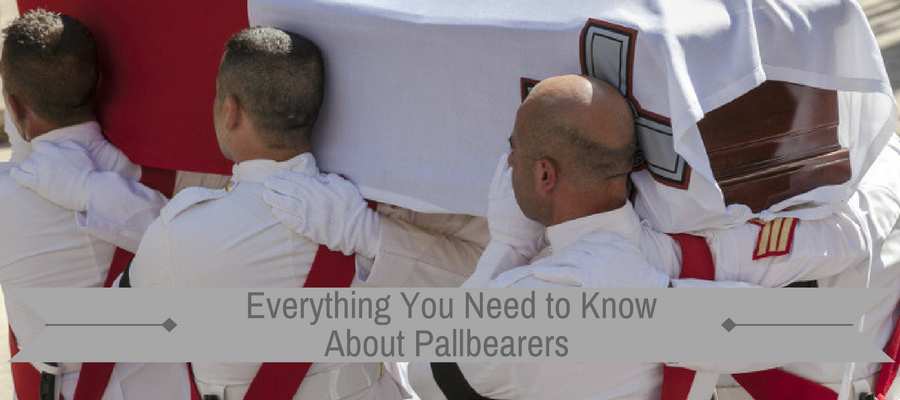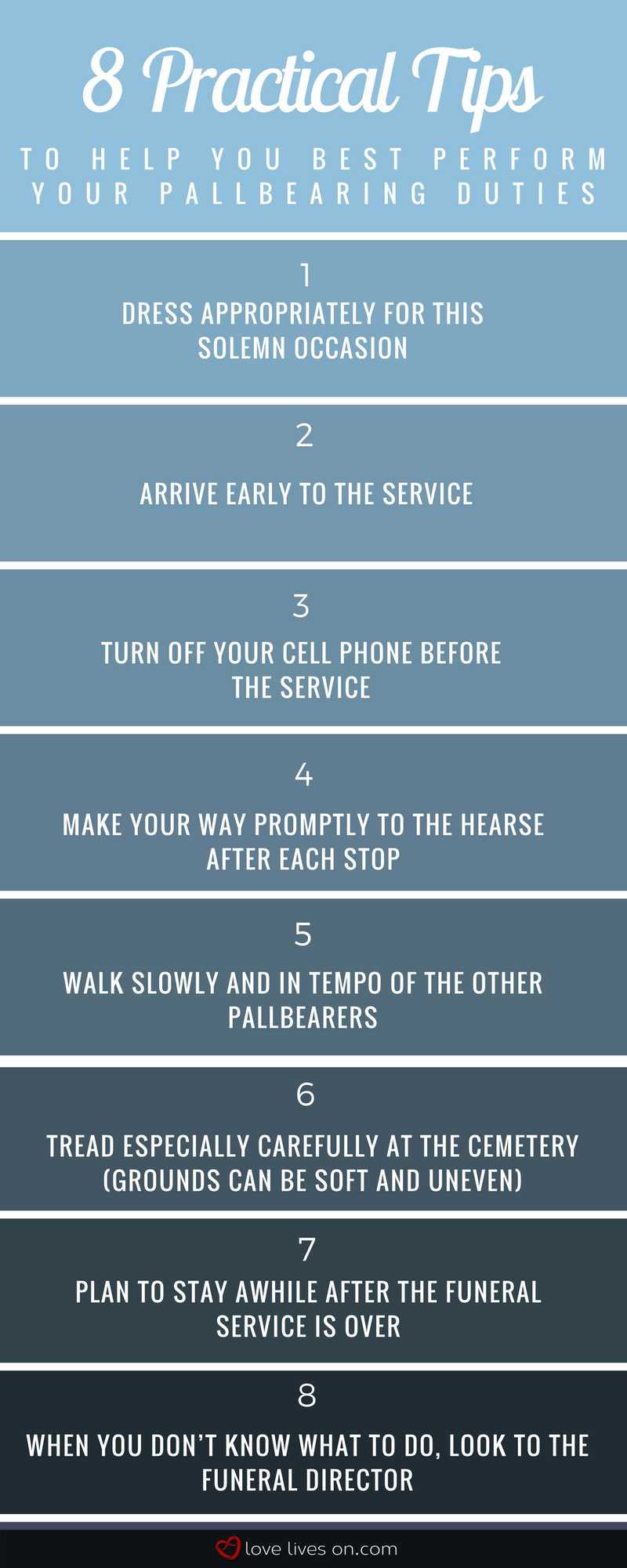
Have you ever wondered why people who carry the casket at a funeral are called “pallbearers”? Why aren’t they called “casket carriers” instead?
This post will cover everything you need to know about pallbearers: the duties of pallbearers and honorary pallbearers, whom to select, the procedures pallbearers typically follow on the day of the funeral, tips on how best to carry the casket or coffin, and how to thank pallbearers for their service. (We even throw in a little history behind pallbearing for those that are curious…)
Whether you have been tasked with selecting pallbearers for a loved one’s funeral, or asked to serve as a pallbearer, we have the answers to all your questions.
Let’s get started…
1. What is a Pallbearer?
Today, the term ‘pallbearer’ refers to a person that helps carry the coffin or casket of the deceased.
The beginning of the long history of pallbearers dates all the way back to ancient Rome. When a Roman died, his cloak or “pallium” was draped over his body or coffin while it was carried from his home to the cemetery on the shoulders of strong men.
By the medieval period, the term “pallium” was shortened to “pall”. The “pall” was used in Christian ceremonies to cover the coffin during the church ceremony. The pall was rectangular in shape and highly decorative, often bearing an elaborate coat of arms.
A group of men would carry the coffin to and from the church, while another group of men would hold onto the hem of the pall so that it did not blow away in the wind.
Today, while we no longer have people whose role is to hang onto the hem of the pall during the procession, we still have a tradition of carrying or accompanying the coffin or casket of the deceased.
2. Are Palls Still Used Today?
Palls are still used in funeral services today, particularly in religious services.
In Christian traditions, the pall is used to symbolize two things: first, it symbolizes the clothes worn during baptism; and second, it symbolizes that all are equal in the sight of God (since the pall covers all caskets completely).
In the Jewish tradition, the casket is also covered completely by a pall, which is a specially prepared cloth.
In military and State funerals, the national flag is draped over the casket as a pall. Strict and formal etiquette governs how the flag is placed.
For example, in US military funerals, the canton should be draped over the upper left corner of the casket. The flag is then removed after the funeral service, immediately before the casket is lowered into the grave.
3. When Are Pallbearers Appropriate?
Pallbearers are appropriate at funerals. Since the role of the pallbearers is to carry or escort the casket, pallbearers are not needed at ceremonies where the deceased’s body is not present, for example, at a memorial service or a life celebration.
However, ceremonial carrying roles can still be created for memorial services and life celebrations. If the cremated remains are present, the family of the deceased could ask a person that was special to the deceased to carry the urn. The family could also have people carrying a picture of the deceased or flowers following the conclusion of the service.
The family could also have honour guards. The honour guards could, for example, flank the entrance into the venue where the service is being held. Today, there are many options for including people that were close to the deceased in the ceremony.
4. Who Can Be a Pallbearer?
Traditionally, men acted as pallbearers because of the strenuous nature of the task. Before motor vehicles became commonplace, caskets often had to be carried many miles from the deceased’s home to the church, funeral home, or cemetery.
Another tradition was that pallbearers were not members of the deceased’s immediate family. The rationale was that close family members needed time to focus on their own grief, rather than being concerned with transporting the deceased’s body.
Today, however, anyone can be a pallbearer. You can be part of the deceased’s immediate family, and you can be a woman.
5. How Should You Choose Pallbearers?
While there are no longer social expectations surrounding who can and cannot be a pallbearer, there are still four practical considerations:
- Relationship with the deceased: In Western cultures, being asked to perform a role in a funeral service is a great honour that is typically reserved for people that had a close relationship with the deceased. Siblings, adult children and grandchildren, close friends and colleagues, are all popular choices for pallbearers.
- Availability: Pallbearers need to physically present at the funeral. Confirm first that the people you want as pallbearers, particularly those that live far away, will be attending the funeral before you make your request.
- Punctuality: Pallbearers must show up on time so that the funeral service is not unduly delayed. Be wary of asking people that are perpetually late. (A person that everybody else says would be “late to his own funeral” because he has no regard for time.)
- Physical Strength: Carrying a casket is a physically demanding role, even if the weight is distributed among many people. Pallbearers carry the weight of the deceased person, as well as the weight of the casket itself. The weight of a standard adult casket is approximately 200 lbs (or 90 kgs). However, a higher-end casket can reach 400 lbs (or 181 kgs) in weight. The pallbearers may also have to carry the casket up or down a flight of stairs or over uneven terrain. Given the physically demanding nature of the role, pallbearers should be able-bodied, without any disqualifying health issues (like heart and back problems).
6. How Many Pallbearers Are Needed?
Normally, six people are required to carry a standard-sized adult casket (three on each side). However, depending on circumstances such as weight concerns or awkward stairs at the church, more people may be required to ensure that the casket is transported safely.
Some caskets have an additional handle on the front and back, which makes it easy to have eight pallbearers.
For a child’s casket, less pallbearers are needed. The number will obviously depend on the size of the casket.
Most funeral directors will confirm the number of pallbearers available the day before the funeral service to ensure a sufficient number. If a family cannot secure enough pallbearers, the funeral home will normally make provisions for its staff to step in and perform this service.

Related Articles

7. What are Honorary Pallbearers?
People who escort the casket, but not actually carry the casket, are called “honorary pallbearers”. They can walk in front of, beside, or behind the casket. There is no limit to the number of honorary pallbearers you and your family can choose. Abraham Lincoln had 22 pallbearers when he died in 1865.
Having honorary pallbearers are appropriate in several different situations.
When a person who had a close relationship with the deceased is physically unable to carry the casket, he or she may still participate in the ceremony by accompanying the casket as an honorary pallbearer. This includes ill or elderly relatives, as well as children and youths. Children are especially well suited to acting as flower bearers.
Honorary pallbearers are also preferable when the casket is particularly heavy. In this case, the funeral home personnel will use mechanical power instead of human power to move the casket, but honorary pallbearers will accompany the casket.
A third situation where families should consider having honorary pallbearers is when it is difficult to choose from a large pool of candidates.
Extra people can be designated as honorary pallbearers and participate in the funeral procession. They can also form a line of honour guards at the conclusion of the funeral service and, or, at the cemetery.
8. How Are Caskets Carried?
How a casket is carried is dictated by national customs.
For example, in the U.S.A., pallbearers carry a casket by the handles and at waist height. While in the United Kingdom and Ireland, pallbearers carry the casket on their shoulders—the casket handles are used to help lift the casket out of the hearse or funeral car and to assist in lifting the casket onto the pallbearers’ shoulders.
The funeral director will be able to direct you on the proper way to lift and carry a casket if you are unsure.
9. What Procedures Do Pallbearers Typically Follow on the Day of the Funeral?
Each funeral is, of course, unique. Having said that, there are procedures that pallbearers typically follow on the day of the funeral.
Typically, the pallbearers arrive at the funeral home. They wait outside while the deceased person’s family says their final farewells. They will usually have an opportunity to speak with a funeral director who will give them instructions regarding the procedures for the day and where to park their vehicles.
Once the family has left, the pallbearers will enter the funeral home to assist with lifting the casket onto a wheeled device called a “church truck”. They will then roll the casket out of the building to where the hearse (a vehicle designed for transporting caskets) is parked.
The pallbearers will lift the casket together and place it in the back of the hearse.
The pallbearers will then make their way back to their own vehicles for the procession. If there is a designated pallbearer car, it will travel directly in front or behind the hearse, depending on the funeral director’s instructions. All other cars are behind the designated pallbearer car.
Once the hearse arrives at the place for the funeral service, it parks as close as possible to the entrance. The pallbearers lift the casket from the back of the hearse and carry it to the entrance of the building.
If it is a Christian service, clergy will usually meet the pallbearers at the entrance, along with any honorary pallbearers. The clergy will perform a brief blessing and place the pall (a ceremonial covering) over the casket.
When the procession is ready to move, the music starts. The pallbearers then carry the casket to the front of the congregation. However, if the aisle is too narrow, the casket may have to be brought in by the funeral directors using the church truck. In this case, the pallbearers would walk in front of the casket, two-by-two. If there are any honorary pallbearers, they would also walk in front of the casket, two-by-two.
During the funeral service, the pallbearers and honorary pallbearers will either sit together for convenience (usually in the front row, left side), or be seated with their families.
At the end of the funeral service, the casket will travel back down the aisle in the same manner as its entrance.
If it is a Christian service, clergy will usually give a final blessing just before the deceased person leaves the church. The pallbearers will then carry the casket and place it in the back of the hearse.
The procession will then travel to the cemetery. Upon arrival, the pallbearers will again carry the casket from the back of the hearse to the graveside. The honorary pallbearers will walk in front of the casket again, two-by-two.
Once they reach the graveside, the pallbearers will place the casket onto a device that will be used to lower the casket into the ground.
The last duty of pallbearers and honorary pallbearers may be to line up as an honour guard on the far side of the casket (opposite to where the family is standing or seated). They may be given a flower at the conclusion of the ceremony and asked to place the flower upon the casket before it is lowered into the ground.
10. What Advice is Helpful for Pallbearers?
If you have been asked to be a pallbearer, you no doubt realize that it is a great honor.
You should never refuse a request to be a pallbearer unless there is a very good reason to. As examples, you are physically incapable, struggling with unmanageable emotional distress following the death, or unable to attend due to the travelling distance.
The following tips will help you perform your duties as best as you can:
- Dress appropriately for this solemn occasion: It is important that you show respect by wearing funeral appropriate clothing. If you are a man, wear a suit with a white, long-sleeved shirt, and a conservative tie. If you are a woman, wear a conservative dress along with sensible shoes that allow you to carry the casket without tripping.
- Arrive early: Make sure that you arrive at the funeral home at least thirty minutes prior to the procession’s departure to the church (or other venue). This will give the funeral director adequate time to instruct you on pallbearing procedures and etiquette. You can also discuss which side you would prefer to carry on. It is important that you understand all of the funeral director’s instructions.
- Turn off your cell phone: Before you pick up the casket, make sure your cell phone has been turned off. Once you are carrying the heavy load, it will be impossible to do so. It would be very embarrassing to be walking down the church aisle carrying the casket when your cell phone rings.
- Make your way prompt to the hearse after each stop: Make sure that you are present and accounted for as quickly as possible at each stop. Do not be distracted by other funeral guests that wish to chat with you, as is considered rude and thoughtless to keep the family of the deceased waiting.
- Walk slowly and in tempo: Do not rush when you are carrying the casket. Walk slowly and steadily, making sure to gauge the tempo of the other pallbearers as you carry the casket.
- Tread especially carefully at the cemetery: The cemetery grounds can be soft and uneven. You should also be careful to not trip over the device that lowers the casket into the grave. (You will be required to place the casket on top of this device.)
- Plan to stay awhile after the funeral service is over: It is customary for the funeral party (which includes pallbearers) to stay after the funeral service has finished to speak with the funeral guests. It also gives the family a chance to personally thank you for your service during this important occasion.
- When you don’t know what to do, look to the funeral director: When you are unsure of what to do next, the funeral director will either give you verbal directions or non-verbal cues.
We know that’s a lot to remember so we’ve summarized these helpful tips into an infographic that you can easily save directly to your Pinterest page or share on social media.
(Click infographic to enlarge)
Like our infographic? Use it on your site by copying this code:
11. How Do We Thank Pallbearers for Their Service?
In our modern era, funeral directors have mechanical devices to physically carry caskets. Many people would therefore argue that the most important role pallbearers play is ceremonial, that their service is symbolic of bearing the bereaved family’s burden, the burden of the dead. Pallbearers do this work out of love for the deceased and his or her bereaved family.
It is customary for the family of the deceased to send a thank you note to each pallbearer. Sending thank you notes after the funeral is a way of expressing gratitude to these special men and women that provided the family with support and comfort during a difficult time.
Do You Have Any Advice from Personal Experience?
If you found this post on pallbearers helpful, we would appreciate a Facebook Like.
You can also follow our Pinterest Board for more resources and practical tips for pallbearers.
If you have been a pallbearer, do you have any advice based on your personal experience? What do you wish you had known before the funeral service? We’d love to hear from you in our comments section below.




